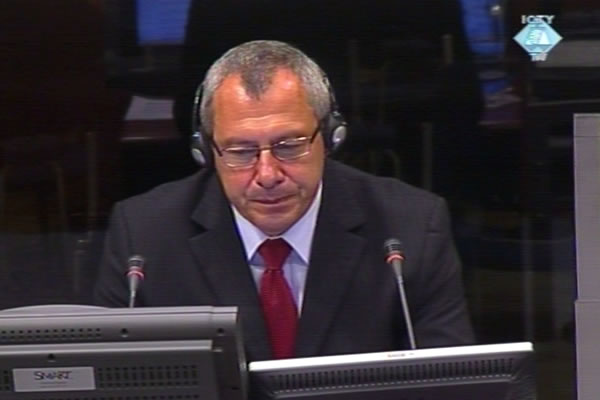Home
KARADZIC FALLS BACK ON SUNSHINE AND SHADOWS IN HIS DEFENSE
In a bid to contest the reliability of a book and interactive CD produced by the prosecution, Karadzic called on the Sun and shadows to help him. The book and CD are based on the video footage recorded by Belgrade journalist Zoran Petrovic Pirocanac. French inspector Jean-Rene Ruez, former head of the OTP Srebrenica investigation team, began his evidence later today
 Tomasz Blaszczyk, witness at Radovan Karadzic trial
Tomasz Blaszczyk, witness at Radovan Karadzic trial The examination-in chief of investigator Tomasz Blaszczyk continued at the trial of Radovan Karadzic. A collection of documents from the VRS Drina Corps was admitted into evidence. It contains about 350,000 pages of various documents drafted by the Drina Corps units and their superior command, some 360 maps and over 3,000 photos. The materials were found in December 2004 in a military barracks of what was the Army of Serbia and Montenegro at the time.
In the cross-examination, Karadzic contested the authenticity of the documents, arguing that the Drina Corps archives had disappeared after the war in BH, only to ‘reappear suddenly’ nine years later, Karadzic noted. Karadzic put it to the witness that in the intervening period many documents may have been ‘removed’ from or ‘added’ to the Drina Corps archives. The witness didn’t deny this, but offered an alternative explanation for the sudden disappearance of the archives.
Blaszczyk recalled that after the war, a number of VRS barracks were searched. It was obvious, Blaszczyk noted, that the Tribunal was also looking for the documents of the Drina Corps, which took part in the operations in the Srebrenica area in July 1995. In the witness’s opinion, this was the reason why the Drina Corps archives were taken out of the country. The archives were not in ‘private hands’ as Karadzic suggested, but in the possession of the Army of Serbia and Montenegro, the witness explained.
Karadzic contested the ‘usefulness’ of the book and the interactive CD with the sketches and photos of Srebrenica sites that the prosecution prepared based on Zoran Petrovic Pirocanac’s video taken on 13 and 14 July 1995. The accused claimed that on some photographs, the witness did not accurately mark the direction of Pirocanac’s movements.
To prove his point, Karadzic called on the Sun for help. As he said, the Sun is the only ‘witness that cannot be bought’. Karadzic first spent considerable time to prove a rather uncontroversial fact: as the day progresses, the Sun moves from the east to the west, and consequently, shadows move from the west to the east. The witness responded simply that the route Pirocanac took was winding, and the arrows he used to mark Pirocanac’s movements did not necessarily correspond to the points on the compass.
After Tomasz Blaszczyk completed his testimony, the prosecution called French police inspector Jean-Rene Ruez, who headed the OTP Srebrenica investigation. Ruez visited the Srebrenica area for the first time on 20 July 1995 to verify media reports about thousands of missing Muslim men. In the years to come, Ruez returned to the area several times in an attempt to reconstruct the events after the Serb forces overran the Srebrenica enclave on 11 July 1995.
In the examination-in chief, Ruez went through the key stages of the Srebrenica investigation. After the OTP staff gathered the preliminary information from interviews with eyewitnesses, survivors and the UN personnel who had been stationed in the Srebrenica area, they embarked on a search for evidence to corroborate the witnesses’ statements: execution sites, mass graves and detention facilities. In the third phase, the investigators identified the perpetrators, carried out searches of military facilities looking for documents, and finally brought the accused before court to prove their responsibility in a trial.
Jean-Rene Ruez continues his evidence on Friday, 27 January 2012.
Linked Reports
- Case : Karadzic
- 2012-01-25 ON TRAIL OF PIROCANAC’S SREBRENICA VIDEOS
- 2012-01-24 YEARS OF HUNGER AND DEATH IN SREBRENICA
- 2012-01-20 KARADZIC’S MOTION TO RECALL 12 ‘MUNICIPALITY WITNESSES’ REJECTED
- 2012-01-27 KARADZIC WANTS INTERVIEWS WITH GREEK PRESIDENT AND FRENCH OFFICER
- 2012-01-27 RECONSTRUCTING THE CRIMES IN SREBRENICA
- 2012-01-30 BADLY ELIMINATED TRACES OF CRIME
